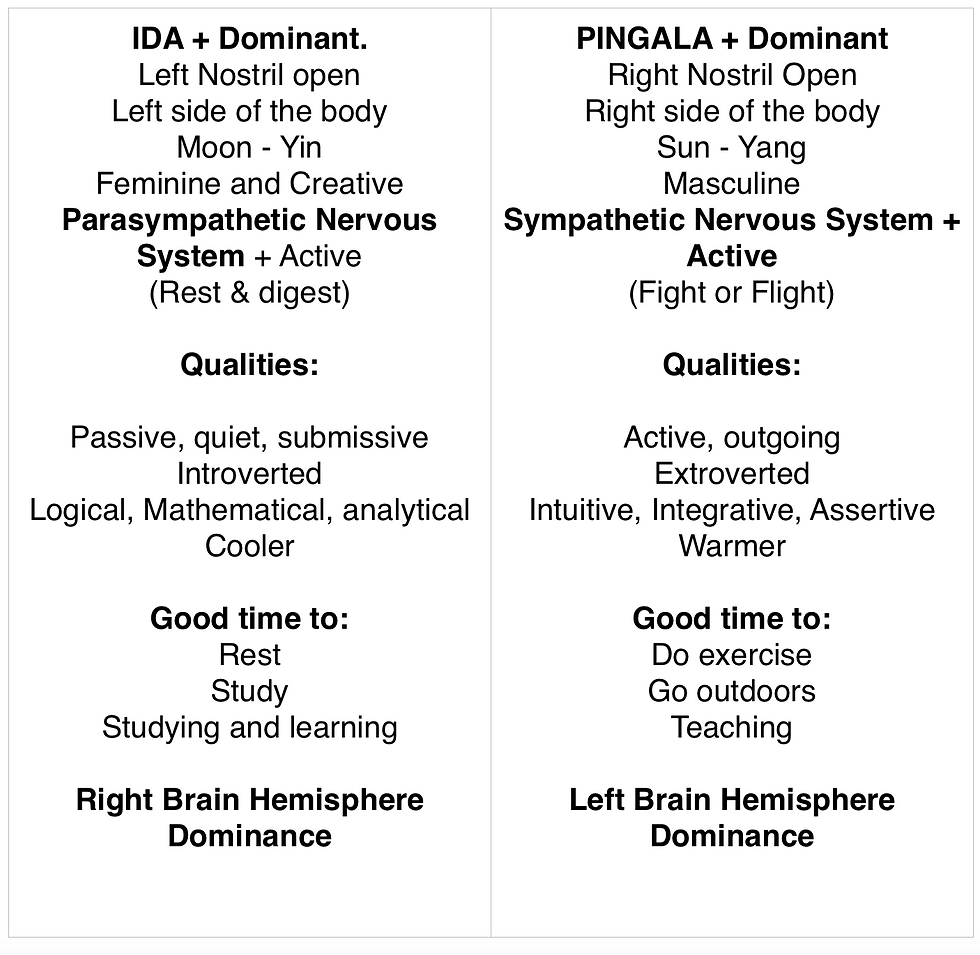The Daily Breath
- Amor Armitage
- Jul 16, 2017
- 3 min read
“When the breath wanders, the mind is unsteady, but when the breath is still, so is the mind still.” Hatha Yoga Pradipika

Before you continue reading, pay attention to your breath, which nostril is predominantly open?
(you can cover one nostril and check by breathing in through the uncovered nostril)
In yoga, we normally talk about "nadis" which are energy pathways through which "prana" (divine energy, life force) flows through. These pranic channels intersect the "chakras" along the spine. There are three main nadis, Ida, Pingala, and Sushumna.
If your right nostril is flowing more freely, it means that "Pingala" nadi is active, and this is a great time to do any physical or energetic activities. Pingala represents the sun qualities and then on the other side, if your left nostril is predominantly open, "Ida" which represents the passive qualities of the moon is in control, and this is a great time to do quiet activities such as reading and studying. If both nostrils feel equally open, Sushumna, the main channel is active and it is the best time to meditate.
What is fascinating to know is that these nadis are connected to the brain hemispheres and nervous system, so the way you feel, act and think in every moment of your life, it is not simply determined by your personality, but by so many other factors, and today I will concentrate on "nadis" and their influence on which side of the brain will operate predominantly based on which nostril is flowing more freely!!

The dominance of each nostril fluctuates often during the day according to the activities that we undertake. It is believed that positive and friendly experiences will help activate our left nostril breath flow predominance, and with it, our PSNS and its rest and digest mode, or the contrary if we experience a scary, shocking, or nerve wrecking experience which will trigger our Pingala Nadi predominance, with its fight or flight response.
Our ideal is to have the breath flow balanced through both nostrils, so that we are not always operating predominantly from one brain hemisphere or the other, but on a harmonious combination of both. When one nostril is continuously blocked, you will notice the effects that is has on moods, energy, etc. If your right nostril is constantly blocked, you might experience a lack of energy and feel introverted, similarly, if your left nostril is regularly constricted, you might have a hard time learning or concentrating on a task.
Before I practice pranayama (breathing exercises) in the mornings, I check which nostril is receiving more air, and then I practice for around 5 minutes. I personally love "Nadi Shodana Pranayama" (Alternate nostril Breathing) as it really helps balancing the flow of prana through both nostrils and it makes them feel both more open. If you have a blocked nostril due to a cold or anything similar, you can lie on the side of the body on which the nostril is predominantly open for a couple of minutes and the other nostril (which will be on the higher part of the body as you lie sideways) will start to open up.
There is so much to ourselves than we are aware of, this is one of the things I read many years ago in a book called "Practical Yoga Psychology " by Dr Rishi Vivekenanda where I realised how important breath is and how much it impacts all aspects of our lives. This is actually a science called "Swara Yoga" which existed even before the Vedic period and studies the breath and its relation to the balance of our energy, so if your asana practice, creativity, energy levels, etc. is not the same every day, there is a reason and that's why it's good to have your breath in check.
If in any particular day you need to study, and your active right nostril is more open, you can switch the current of breath flow, and open up the left nostril by either laying down on the right side for a couple of minutes, or making a fist with your left hand and placing it under your right armpit and gently press down on it, or do a few rounds of Nadi Shodana pranayama
I hope this helps and brings more understanding to why we bring so much attention to the breath, the practice of knowing ourselves will be a never ending practice, and to make the most of an instrument, such as our breath, we first need to know how to use it =)
Love and light,
Amor

